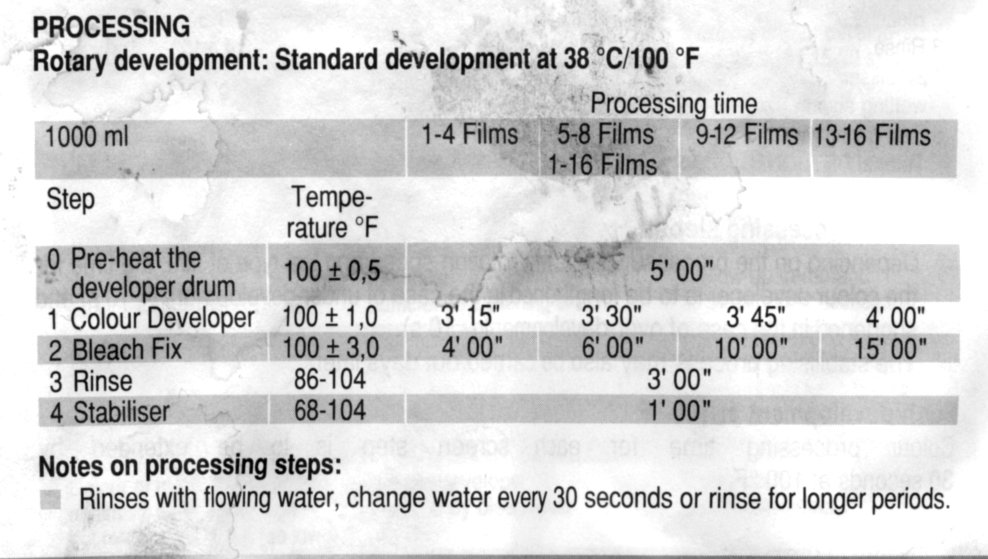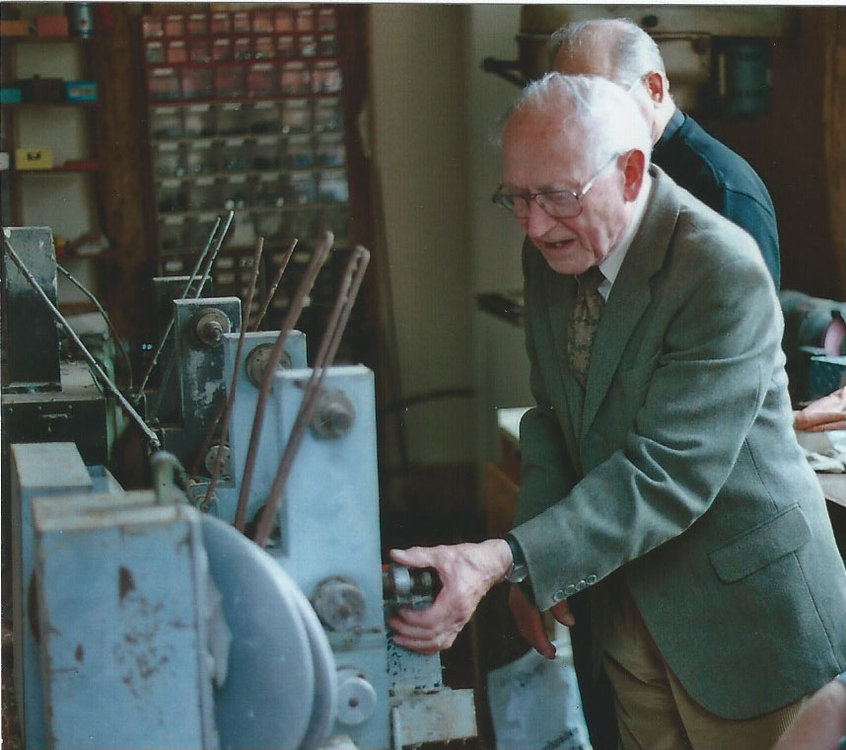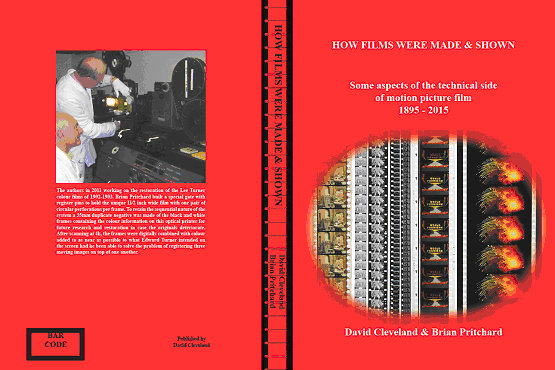
Brian Pritchard
-
Posts
341 -
Joined
-
Last visited
Posts posted by Brian Pritchard
-
-
I am sorry go have to announce the death of Roland (Rex) Ebbetts at the age of 97 on the 13th March 2022. He was managing director of Filmatic Laboratories until his retirement in 1988. He was a cameraman for the Army Film Unit during the Second World War. He worked as a for MGM as Print Manager after the war before moving to Filmatic as Technical Manager. He was president of the BKSTS during the early 1970's.
Brian
-
We have digitally printed editions just arrived and we have been able to reduce the price. It is £50 post paid to Uk addresses and £65 post paid to overseas addresses.
You can order it from: www.localeastanglianbooks.com
Brian
-
It is Emulsion Number 501 Roll16 Cut 1. The 2000 ft rolls would have been cut into 2 parts before cutting down to 400 ft lengths
Brian
-
 1
1
-
-
I am interested to know what you feel about the future of 3D. I am also interested to know if you think that the current necessity of wearing glasses has contributed to the loss of interest in 3D films. If 3D was available without the need for glasses would it encourage the production of 3D features? It is also important to know if the addition of 3D to a film other than those made with mainly special effects makes a contribution to the increase in its audience?
I would be grateful for any opinions you have.
Thanks
Brian
-
I believe they used hot foil printing to produce coloured sub-titles.
Brian
-
David, I am glad you have ordered a copy; I hope you enjoy it. Sorry to be so late to reply, I am just about retired now so I don't check the forum very often.
If anyone has a problem with the book please let me know and I will sort it out.
I don't want to get involved with Amazon, we sell the book at virtually cost so I don't want them taking a share. You certainly don't want to pay $238 when you can get a copy for £60.
Brian
-
Just to let you know that we have a few digitally printed soft-back copies available. They can be purchased from
www.localeastanglianbooks.com
Brian
-
I have just checked a copy of the Kodak Price list for 1977. It does show 5302 available with both pos and neg perfs.
It would be worth developing a section of your film as there could well be other information printed as a photographic image. Possibly a stock manufacturer, perforator number and strip number for example.
Brian
-
I don't believe that Kodak used ink edge printing on 5302 (B/W Fine Grain release positive) and it would not have edge numbers a it was a pos stock. It is possible that 5302 could have been produced with neg perfs but it would be unusual. Kodak duplicating stock 5366 (Fine grain duplicating positive) always had a 'D' prefix to the edge number. Incidently the horizontal line between the perfs indicates that the base is safety.
Brian
-
We printed 400 copies. We are not going to print a 2nd Edition, we would have to order the same number for it to be economic and it is likely that we would get left with most of them - we are talking about £10,000 and as we published it ourselves we can't afford to risk that amount of money.
We are not planning to sell PDF copies.
Brian
-
Just to let you know that all copies of our book have now been sold and it is out of print.
Thanks
Brian
-
Hello David
You can't bleach reversal back to negative, if you bleach it you will end up with clear film. You should ensure that the film has been correct washed and then store it in cool, dry conditions, the colder the better. If the film is stored in very cold conditions you should always allow it to warm up before opening the can to avoid condensation. If possible it is good to rewind the film to the other end regularly, once a year would be good.
Brian
-
This is part of the C41 kit that is used for processing Kodacolor, Fujicolor, Vista and so on, stills film. The kit comes as a 1litre or a 5 litre set of solutions. There are three parts to the developer, two parts to the Bleach-Fix and 1 part to the stabiliser. Normal processing is at 38 degrees C. Here is the processing details.
-
Flashing the positive will give a tinted print - that is the whites are coloured and the blacks remain black. Films were sometimes screened using a coloured filter over the projector which gives the same effect.
Toning colours the blacks and the whites remain white. You achieve toning by printing a black and white negative with coloured light.
A tinted and toned print has coloured highlights and coloured shadows. There are samples of all three on my website.
Brian
-
If you don't want to produce tones and tints chemically the usual way to get tint and tones is to use the method perfected by Noel Desmet of the Royal Belgian Archive. To get a blue tint you pre-flash the colour positive stock with yellow light and then print the black and white negative onto the pre-flashed stock. You need to do tests to ensure that the image is neutral. Obviously you can get any colour tint you want by flashing with the opposite colour.
To get a blue tone it is just a question of grading the black and white image to give the colour you want. Usually you use a Wratten 85 filter of a piece of clear colour negative stock to ensure that you are able to grade the negative to the colour you want. Again you can do both and end up with a tinted and toned image. It is just necessary to do tests to ensure that you get the right result.
If you just want tints you can use food dyes which are obviously not toxic (hopefully) as are most of the dyes recommended in articles such as you will find on my website
http://www.brianpritchard.com/tinting_and_toning_of_eastman_po_4ed.htm
Brian
-
Thanks Mark.
I have finally written to him; it just takes a letter a long time to get there.
I am pleased to say the Academy in Hollywood has just ordered a copy for their library. Fame at last!!!
Brian
-
Thanks for the kind remarks, the sales of the book are going well.
I have had an order by letter from R A Saffrey MBKS of Shenton Park in Western Australia, in order to send him his book I need a telephone number for the courier. Does anyone from Western Australia know this gentleman and have a telephone number or email address?
Thanks
Brian
-
Some of you might find this of help: http://www.brianpritchard.com/why_colour_negative_is_orange.htm
There are some scans of colour negative layers with and without masking. These slides I helped to make in the 60's for a lecture by Dr R W G Hunt on colour reproduction when I worked in the Kodak Research laboratories at Harrow in England. Emulsions were specially coated as single layers to illustrate the effects of masking which cannot be seen any other way.
Brian
-
-
I am sorry to say that Bill Vinten of Vinten camera fame died on the 8th November 2015 aged 95. My Colleague David Cleveland has written an obituary which I have attached.Bill Vinten.doc
Brian
-
Hello Carl
I have done a quick check and the cost to Australia would be £60.; I am afraid that the book is large and heavy (2.4Kgs -A4). The cost to the US is £52. The 'Buy Now' option on my website is for UK delivery only and international deliveries should be paid by Paypal directly to my email brianrpritchard@aol.com.
Thanks
Brian
-
Hello Bill
I do have quite a large number of film stock data sheets so if I can help just let me know. My email address is brian(at)brianpritchard(dot)com.
Best wishes
Brian
-
My good friend, David Cleveland and I have just published 'How Films Were Made And Shown'. It is A4 with 453 pages and 900 illustrations, many in colour. It is quite a heavy tome, 2.5 kgs. Kevin Brownlow on receiving his copy said "the book is not only unputdownable - it is heavy enough to be unpickupable!"
For film archivists and those interested in the technical side of film, there are chapters on How It Worked; The Film Business Gets Going; The 1920s - Time of Change; A Quest For Colour; The 1930s and 40s; New Film, New Colour, New Sound, New Screens of the 1950s and 60s; The Film Laboratory, and Slow Fade Out covering from the 70s to 2015.
If you would like further information please look at my website:http://www.brianpritchard.com/How_Films_Were_Made_and_Shown.htm.
Unfortunately the weight makes it rather expensive to ship.
Brian
-
 2
2
-
-
I believe that they are still processing 35 mm colour positive which I-dailies cannot do.
Brian





Methods for contrast control in intermediate stages
in Film Stocks & Processing
Posted
Sorry to join in so late. The main problem with altering the development time on all colour films is the fact that the three layers respond differently giving you colour mismatch. for example green shadows and magenta highlights. As David says altering the contrast of black and white separations is the correct way to go photochemically.
Brian